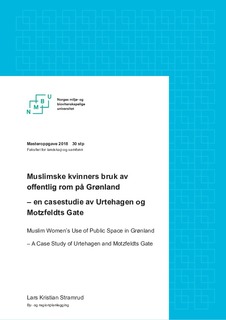| dc.contributor.advisor | Murphy, Melissa Anna | |
| dc.contributor.advisor | Sirowy, Beata | |
| dc.contributor.author | Stramrud, Lars Kristian | |
| dc.coverage.spatial | Norway, Oslo | nb_NO |
| dc.date.accessioned | 2019-01-29T13:14:05Z | |
| dc.date.available | 2019-01-29T13:14:05Z | |
| dc.date.issued | 2018 | |
| dc.identifier.uri | http://hdl.handle.net/11250/2582845 | |
| dc.description.abstract | Det er i dag en bred enighet om at offentlige rom skal være tilgjengelig og inkluderende for alle mennesker i samfunnet. Samtidig blir Oslo — i likhet med vesten generelt — stadig mer multietnisk. De offentlige rommene på Grønland speiler på mange måter en situasjon som i fremtiden vil bli mer og mer aktuell i de fleste urbane strøk: Mennesker fra hele verden preget av forskjellige sosiale og religiøse normer lever side om side og skal ta i bruk de samme offentlige rommene. I lys av dette dukker det opp flere problemstillinger om hvem rommets brukere er og hva som former denne bruken.
Den feministiske diskursen rundt byplanlegging og arkitektur har i all hovedsak omhandlet kjønn generelt og fremmet viktigheten av kjønnssensitiv planlegging for å oppnå rettferdige og demokratiske offentlige rom. Denne oppgaven har samme tilnærming, men argumenterer i tillegg for viktigheten av å anerkjenne forskjellene innad i kjønn. Religiøse og sosiale normer er — særlig i islamsk kultur — kjønnsavhengige faktorer som legger føringer for hvordan offentlig rom oppfattes og brukes.
Oppgaven kombinerer klassiske teorier om offentlig rom med teori om feministisk urbanisme, territorialisering og offentlig rom i islamsk kultur. Gjennom et casestudie og observasjon av offentlig rom på Grønland innhentes empirisk data som påviser rommets faktiske brukere fordelt på kjønn og religiøs tilknytning. Studien viser at muslimske kvinner er underrepresentert i å bruke caseområdet som en sosial arena.
For å få en dypere forståelse for den kjønnede bruken er det gjennomført intervjuer av muslimske kvinner på Grønland. I lys av funnene fra observasjon og intervju diskuterer oppgaven årsaker til den kjønnede bruken og hvilke tiltak man som planlegger kan gjøre for å fremme muslimske kvinners bruk av offentlig rom. | nb_NO |
| dc.description.abstract | A fundamental principle in contemporary planning is that public spaces should be accessible for everyone. Meanwhile is Oslo — akin to the West in general — becoming more and more multiethnic. In many ways, the public places in Grønland mirrors a situation which in the future will be more and more relevant in urban places: People from all over the world with different religious and social norms will be living side by side and use the same public spaces. This raises certain issues regarding how people use public space and on what terms this use are shaped.
The feminist discourse related to urban planning and architecture has originally dealt with gender in general and promoted the importance of gender sensitive planning to secure fair and democratic public spaces. This thesis shares this approach, but are also arguing for the importance of recognising that differences also exist within gender. Religious and social norms are — especially in islamic culture — gender dependent factors which influences how public place are perceived and used.
This thesis combines classic theories on public space with feminist theory on urban planning, territorialization and how public space is perceived in islamic culture. Through a case study and field observation in Grønland, empirical data is collected to illuminate who the actual users of this space are based on gender and religious affiliation. The study shows that muslim women are underrepresented in using public space in Grønland as a social sphere.
To gain a deeper understanding of this gender specific pattern, interviews of muslim women in Grønland are conducted. In the light of the findings from the field observation and the interviews, the thesis discusses possible causes of why the use of public space in Grønland are vastly gendered. Based on this discussion — and within the planners role of action — a list of measures are presented that potentially can increase muslim women’s use of public space. | nb_NO |
| dc.language.iso | nob | nb_NO |
| dc.publisher | Norwegian University of Life Sciences, Ås | nb_NO |
| dc.rights | Attribution-NonCommercial-NoDerivatives 4.0 Internasjonal | * |
| dc.rights.uri | http://creativecommons.org/licenses/by-nc-nd/4.0/deed.no | * |
| dc.subject | Urban planning | nb_NO |
| dc.subject | Byutvikling | nb_NO |
| dc.subject | Feminisme | nb_NO |
| dc.subject | Feminism | nb_NO |
| dc.subject | Islam | nb_NO |
| dc.title | Muslimske kvinners bruk av offentlig rom på Grønland : en casestudie av Urtehagen og Motzfeldts Gate | nb_NO |
| dc.title.alternative | Muslim women’s use of public space in Grønland : a case study of Urtehagen and Motzfeldts gate | nb_NO |
| dc.type | Master thesis | nb_NO |
| dc.description.version | submittedVersion | nb_NO |
| dc.subject.nsi | VDP::Social science: 200::Urbanism and physical planning: 230::Urbanism: 237 | nb_NO |
| dc.subject.nsi | VDP::Humanities: 000::Architecture and design: 140 | nb_NO |
| dc.description.localcode | M-BYREG | nb_NO |

